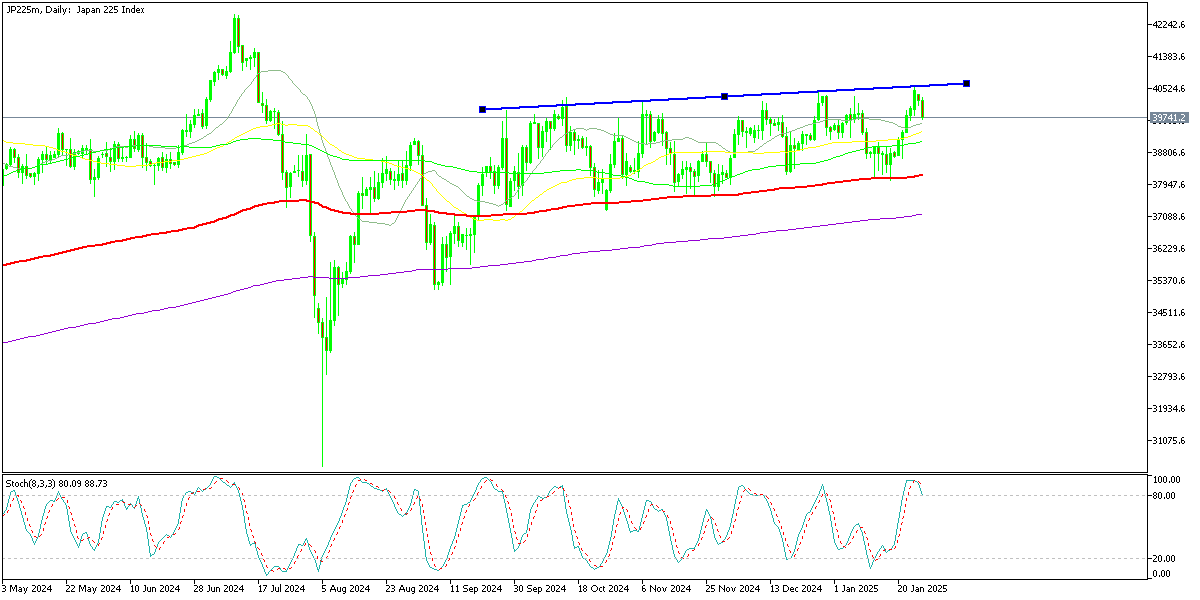Nikkei Dives, Stock Dive As Trump Tariffs Start, Chinese Manufacturing Contracts
The Nikkei index has dived below 40,000 points again, as stock markets and risk currencies fall on tariffs on Colombia and weak economic data from China.

Monday morning saw the markets open with a clear risk-off tone. Risk assets, including commodities, commodity-linked currencies, and stock markets, started the week on a weaker footing. In contrast, the US dollar and Japanese yen showed strength, reflecting a shift toward safe-haven assets as investors grew more cautious. One major factor contributing to this sentiment was US President Donald Trump’s announcement of new tariffs on Colombia, which many interpret as a possible precursor to broader trade restrictions targeting other nations.
The NIKKEI225 has dived 600 points to 39,700 points, following the ascending channel where it has been trading since September 2024. This looks like a good opportunity to wait and buy this index at the100 daily SMA (green) when the price gets down there, s it has been the ultimate support indicator for the Nikkei index.
Nikkei Index Chart Daily – The Price Resecting the Ascending Channel
US-Colombia Trade Tensions Escalate
Trump’s trade measures against Colombia include a 25% tariff on imports, with plans to increase this to 50% within a week. In addition to these tariffs, the US government has implemented financial, treasury, and banking sanctions on Colombia. Colombian officials have also had their US visas revoked under a newly imposed travel ban, while Colombian citizens and goods are now subject to heightened border inspections.
In response, Colombia has quickly retaliated. President Gustavo Petro instructed the country’s international trade minister to impose a 25% tariff hike on US imports, mirroring Trump’s initial move. This escalation in trade tensions has unsettled markets, fueling concerns over economic disruptions and the potential for further retaliatory actions that could impact global trade.
China National Bureau of Statistics (NBS) PMI Data – January 2025
China Manufacturing PMI:
- Reported at 49.1 points, falling short of market expectations of 50.1 points.
- Previous reading stood at 50.1 points, indicating a contraction in the manufacturing sector.
- This decline suggests weaker demand and slowing industrial activity, raising concerns about economic momentum.
- Analysts cite sluggish global demand and domestic headwinds as contributing factors.
China Services PMI:
- Declined significantly to 50.2 points, down from the previous figure of 52.2 points.
- The sharp drop signals a slowdown in the services and construction sectors, which had previously been supporting economic recovery.
- A reading barely above the 50-point threshold suggests stagnation rather than growth.
- Composite PMI:
- Registered at 50.1 points, lower than the previous reading of 52.2 points, reflecting weaker overall business conditions.
- The data indicates broad-based deceleration across manufacturing and services sectors.
- Policymakers may face increased pressure to introduce stimulus measures to support growth.
The disappointing PMI data has raised fresh concerns about China’s economic recovery, with the weaker-than-expected figures suggesting potential challenges ahead. As a result, market sentiment has turned cautious, with investors closely monitoring Beijing’s next moves. There is growing anticipation of possible policy interventions, such as monetary easing or fiscal stimulus, aimed at boosting domestic demand and stabilizing growth. In response to the data, the Chinese yuan experienced a slight decline, reflecting market uncertainty, while Asian equities exhibited a more cautious tone as investors reassessed their risk exposure

















